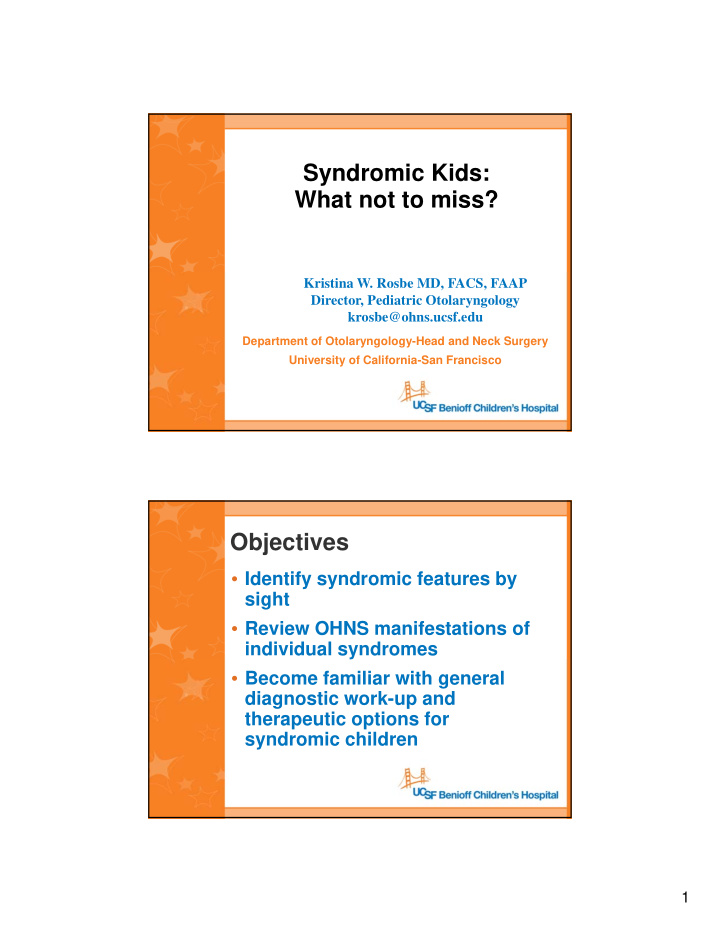



Syndromic Kids: What not to miss? Kristina W. Rosbe MD, FACS, FAAP Director, Pediatric Otolaryngology krosbe@ohns.ucsf.edu Department of Otolaryngology-Head and Neck Surgery University of California-San Francisco Objectives • Identify syndromic features by sight • Review OHNS manifestations of individual syndromes • Become familiar with general diagnostic work-up and therapeutic options for syndromic children 1
Definitions • Syndrome – pattern of multiple anomalies believed to be pathogenetically related – Pathogenesis may or may not be understood – e.g., Treacher-Collins syndrome Definitions • Malformation – Development of a structure is arrested, delayed, or misdirected – early in embryonic life – effect is permanent – e.g., cleft lip 2
Definitions • Sequence – multiple defects that occur as a result of a single presumed structural anomaly – e.g., Pierre Robin sequence 6 3
Down Syndrome Most common syndrome Trisomy 21 – Mostly sporadic – Can have inherited translocation 1 in 700 births Maternal age >35 carries increased risk Classic facies – Midface hypoplasia – epicanthal folds – upslanting palpebral fissures – “macroglossia” Hearing Concerns Conductive hearing loss – more common – small pinna – stenotic EAC – eustachian tube dysfunction – ossicular fixation Sensorineural hearing loss – less common – ossification of basal spiral tract, other inner ear anomalies 4
Hearing Loss Diagnosis • Can be challenging – Small ear canals – Ear specific information • Need Q 6 month audiograms with ear specific information • May need EUA’s for cleaning/assessing middle ear status • T-bone CT • Progressive HL Hearing Loss Treatment • Bilateral myringotomies and PE tubes – Higher otorrhea – Canal stenosis • Amplification – BTE: may be intolerant – BAHA • Need long-term follow-up 5
Other Health Concerns Airway – OSA: Unlikely to be “cured” by T & A alone – Narrow airways • Relative macroglossia – Floppy airways • Pharyngomalacia • Tongue base hypotonia • Acquired laryngomalacia Other Health Concerns Airway 6
Other Health Concerns Airway From: Drug-Induced Sleep Endoscopy in Persistent Pediatric Sleep-Disordered Breathing After Adenotonsillectomy Durr et al. Arch Otolaryngol Head Neck Surg. 2012;138(7):638-643. doi:10.1001/archoto.2012.1067 7
From: Drug-Induced Sleep Endoscopy in Persistent Pediatric Sleep-Disordered Breathing After Adenotonsillectomy Durr et al. Arch Otolaryngol Head Neck Surg. 2012;138(7):638-643. doi:10.1001/archoto.2012.1067 Other Health Concerns Airway – Treatment • Few outcomes studies • Supraglottoplasty • Lingual tonsillectomy • Tongue Base Surgery – SMILE – REPOSE – TONGUE REDUCTION – RADIOFREQUENCY 8
Other Health Concerns • Higher incidence sinusitis – High-arched palate – Narrow nose • GERD/aspiration 9
Goldenhar syndrome (Oculoauriculovertebral) Unilateral craniofacial malformation 1 st and 2 nd arches 1 in 5600 births Sporadic (most) OAVS Facial asymmetry, unilateral ear deformities, and vertebral malformations Auricular malformations, EAC stenosis, ossicular abnormalities – HL in greater than 50% of patients – Usually CHL – SNHL occasionally Facial weakness in 10 to 20% Amplification: typically unilateral HL 10
OAVS Airway Issues Ankylosis of TMJ May be difficult oral intubation 11
Pierre Robin Sequence Phenotype – Micrognathia – Glossoptosis – Cleft palate Incidence 1 in 8500 Etiology can be multiple – positional, genetic, neurologic, connective tissue – Nonsyndromic 80% – Syndromic 20% Pierre Robin Sequence Ear Issues Chronic otitis media with effusion common Palatal abnormality (ETD) Require multiple tympanostomy tubes 12
Pierre Robin Sequence Airway Issues Sleep Study Rule out Laryngomalacia Surgical Intervention Lip tongue adhesion (LTA) Mandibular distraction Tracheotomy Pierre Robin Sequence Swallowing Issues Swallowing assessment Growth monitoring – risk for FTT Intervention Montgomery nipple NG tube G-tube GERD meds 13
Pierre Robin Sequence: the UCSF Experience • 72 patients over 25 years • 31 (43%) had another diagnosed syndrome • 31 had preop sleep studies 15 (48%) normal/mild • 3 (10%) mod • 13 (42%) severe • • 34 lip tongue adhesion • 4 mandibular distraction • 8 tracheotomy (3 decannulated) Pierre Robin Sequence: the UCSF Experience • 22 (31%) required G-tubes • 14 (19%) GERD • 14(19%) laryngomalacia 14
Velocardiofacial Syndrome (VCFS) 22q11.2 deletion – Also diGeorge syndrome Unusual facies – elongated face – almond-shaped eyes – wide nose – small ears – micrognathia – low tone – microcephaly Congenital heart disease Cleft palate – Hypernasal speech Hypoparathyoidism Immune deficiency Learning disabilities 15
Hearing Concerns in VCFS External ear anomalies CHL – 75% – ETD – OME SNHL – 15% Audiology – BTEs may be challenge – BAHA VCFS Vascular anomalies are very common Anomalies of head and neck vessels most common (almost 100%) Caution in planning VPI surgery 16
Summary • It is important to recognize syndromic features in your patients • Early hearing evaluations and amplification are important • Early recognition of airway and swallowing issues • Long-term follow-up imperative 33 17
Recommend
More recommend